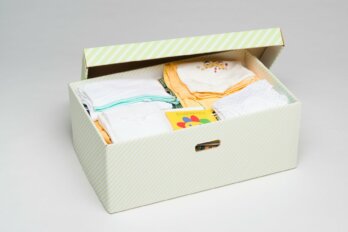Just over a week before Alexandria Ocasio-Cortez won the US Democratic party’s nomination for New York’s Fourteenth Congressional District on June 26, many people had one question for the twenty-eight-year-old political candidate—what was the incredible lip colour she wore during the June 15 primary debate? Usually, the attention we pay to the aesthetic choices of women in politics is, at best, a distraction or, at worst, a way to undermine a qualified candidate. But, in this case, it felt like an expression of love and solidarity. The colour, a blazing red called Beso by Stila, sold out after Ocasio-Cortez tweeted about it.
Seen by some earlier feminists as a tool of patriarchal complicity, lipstick has become a symbol of twenty-first-century feminist revolt across the gender spectrum. It now comes in a rainbow of shades and finishes—from socialist red to nuclear green—untethered from any pretence of enhancing the appearance of health. Oprah wore it in shimmering futuristic metals as she played a godlike alien in A Wrinkle in Time. Musician and writer Vivek Shraya wears it in fire-engine red onstage as she calls out transphobia and racism. As Haudenosaunee writer Alicia Elliott pointed out on Twitter recently, her black lipstick makes her “look like a witchy mistress of death.”
As with any feminist symbol, there has been blowback. In one of his talks, Jordan Peterson, the controversial Canadian academic, argued that wearing lipstick—or anything that accentuates femininity—creates a sexual atmosphere that men are incapable of ignoring. Pointing to fairly contentious evolutionary psychology theories, Peterson claimed that lipstick “indicates a sexual flush” that’s meant primarily to attract a mate. In a recent essay, evolutionary biologist Heather E. Heying takes this reasoning a step further, arguing that women who wear makeup are performing a kind of “toxic femininity.” For Heying this “hotness-amplifying femininity” invites male attention by putting “on a full display, advertising fertility and urgent sexuality.” A woman thus attired, she suggests, is responsible for whatever unwanted attention she attracts. Both arguments boil down to the worn old aphorism “she was asking for it.”
Though they’re working with an antiquated playbook, Peterson and Heying are right about one thing: there is power in lipstick. It can be theatrical, confrontational, glamourous. The names of colours are an absurd kind of poetry—in the book Dietland (which inspired the TV show) Sarai Walker dedicates two full pages to a liturgy of fictional names that go from cheerful (That’s Amore, Just Peachy) to violent (Smack dat bitch, Sex Offender) but all sound possibly real.
Lipstick calls attention to your mouth. It tells a room to read your lips. Yet most women and femme-leaning people I’ve spoken to say wearing it isn’t at all about attracting a mate. They say it’s about visibility or self-expression. They say it gives them joy. To wear lipstick is to be shamelessly, extravagantly, playfully, visibly feminine in a world where masculinity still feels like it holds most of the power.
I’ve been feeling this draw myself more and more lately. A bold lip in red or purple is what I wear when I’m feeling my most fierce or when I want to appear that way. Yet it remains a point of anxiety. It requires commitment, reapplication throughout the day, and an attention to detail I could be applying elsewhere. Maybe it’s strange to come to lipstick in your late thirties, when so many women seem to give it up altogether, but it also feels like now is the time to make a mark.
I grew up in Winnipeg in a neighbourhood of government housing full of single mothers on welfare who did not, as a rule, wear much makeup. Luxuries like facials or visits to salon weren’t in the budget. They painted their own nails. They clothed their strong, fat bodies as beautifully as they could from Zellers or Kmart. They went to Ultracuts for their hair or did it themselves, using box dyes and home perms. Except for the occasional Avon party, glamour wasn’t really part of our lives.
If the women in my neighbourhood did wear lipstick, it was to go to job interviews or work placements, special occasions where self-expression wasn’t the point, where doing your makeup wrong (i.e., tastelessly) would have been as damaging as wearing none at all. Besides, they were too busy trying to keep their families alive to worry about touching up their lips all day long.
But this was also the 1980s, when the pop icons I adored did their makeup with painterly abandon. My favourite cartoon show was Jem. Each Saturday afternoon, I would drop everything to catch the adventures of Jerrica, a kind-hearted heiress who could morph into the magnetic rock star Jem by simply touching her earring and saying, “Showtime, synergy.” Jerrica’s hair was a tasteful blond bob; Jem’s was a pink explosion. Jerrica wore sweater vests; Jem rocked skin-tight dresses with angled ball-gown frills and towering heels. Jerrica was talented and beautiful but shy. She needed the glamour of Jem to feel comfortable in the spotlight.
Because of the similarity in our names, I had to play Jerrica in games of make-believe with the girls at school. When Jerrica transformed, a girl named Jen (for obvious reasons) would step in. I hated this. Jem’s superpower was her spectacle. Playing only Jerrica was like being stuck as boring old Bruce Banner without ever getting to Hulk smash anything. I wanted to be both personas, capable of morphing flawlessly from no nonsense to glamazon in the blink of an eye.
When I was nine or ten, an aunt in Alberta sent me a package of different coloured “lipsticks” arranged on a tray like watercolour paints. In retrospect, I realize it might have been a Halloween thing, clown makeup maybe, but what I saw in that cheap palette of greens, blues, and oranges was the possibility for transformation into my own glamourous alter ego. One afternoon, a friend and I decided to make ourselves into Jem characters. We drew stripes and lightning bolts on our round cheeks, rubbed great swaths of mismatching shadow all the way up to our eyebrows, and painted our lips like big flowers. We regarded our new selves in the mirror, exalted. Our faces were works of art.
Neither of us knew that by painting our faces with such aplomb, we were embodying a salacious version of femininity. We didn’t know that glamour was supposed to come with a price. We just wanted to show the world what we had created, but my mother stopped us at the door. “You can’t go out like that,” I remember her saying. “You look like hookers.”
My mother wasn’t worried about our behaviour so much as the attention we would call to ourselves with all that makeup. She knew how men sexualized little girls who tried to look too grown up. I, on the other hand, had little idea what I’d invoked that day. I didn’t even know the meaning of the word she’d used. As I washed away my fantasy face, all I knew was that there was something about lipstick that was too dangerous to explain to a child.
For centuries, long before bloggers started trying to popularize the term “toxic femininity,” the panic around wearing lipstick was bound up in fear about women’s sexuality. Yet, historically, it was not in periods when women were cloistered and powerless that they wore the most makeup—quite the opposite. In her book Face Paint, makeup artist Lisa Eldridge argues that “the freedom and rights accorded to women during a given period are very closely linked to the freedom with which they painted their faces.”
Sarah Schaffer, in paper called “Reading Our Lips: The History of Lipstick: Regulation in Western Seats of Power,” puts the origin of lipstick about 5,000 years ago in ancient Sumer. There and in ancient Egypt, both men and women painted their lips and faces to signify higher social status. Then, in ancient Greece, where women weren’t allowed to own property or take part in public life, sex workers were legally required to wear lip colour to signify their lower class. If caught without it, they would face punishment for impersonating higher-class women who weren’t allowed to wear it at all. This seems to be where the relationship between bright lip colour and subversive female sexuality became formalized.
As Christianity spread through Europe, cosmetics of all kinds became associated with sin and fell out of favour as women lost even more access to public life. The Christian philosopher Tertullian, who lived around the second century AD, wrote that the technology for cosmetics, as well as how to dye wool and shape precious metals to adorn the body, was taught to humans by angels who caroused with human women. God later condemned those angels to death for toying with his children. Tertullian also called women in general the “devil’s gateway” and wrote a great deal about how women must be modest and silent in order to make up for the sins of Eve. It’s impossible to know how women felt about any of this because the vast majority of the records we have from that time are written by men.
This push and pull between control and self-expression continued for centuries. The first Queen Elizabeth loved lipstick so much, she was said to have worn it half-an-inch thick before her death. For the latter part of the eighteenth century in England, lipstick was associated with witchcraft, both for its seductive properties and for the knowledge of oils, plants, and minerals required to make it.
At many times throughout history, lipstick has been equated with aggressive, predatory feminine sexuality. Those who wore it traded respectability for a different, more disruptive, kind of power. Courtesans wore lipstick because their social standing allowed them to. Suffragettes wore lipstick in bright red as a sign of solidarity and political defiance. Actors—both men and women—wore grease paint to make their features more visible to audiences as well as embody different characters. In the nineteenth century, theatre maven Sarah Bernhardt shocked French society by applying red lipstick in public, laying the groundwork for generations of femmes fatales in books and film who applied their lipstick with titillating relish before the scandalized male gaze. “The grand tragedienne was doing for an audience what she had trained to do backstage,” writes Susan Brownmiller in her book Femininity. “[S]he was making up her face for the fun and drama of it, in the pursuit of excitement and pleasure.”
By the 1980s, lipstick seemed like just another fashion item, yet my mother’s extreme reaction to my adventure in glamour showed that makeup still held the power to unsettle.
Not long after the Jem incident, my mom announced that if I were going to wear makeup, I would need to learn the rules. These rules seemed to exist beyond her and outside our neighbourhood, in the same realm of femininity as fashion magazines and daytime talk shows.
Our nearest portal to this magical realm was the Clinique counter at Hudson’s Bay. There, amidst the glowing white display counters with spaceship curves, a blond woman wearing a white lab coat told me to sit in a tall chair. I studied her powdery skin and glossy lips as she appraised my skin tone and eye colour, turning my face like a jeweller checking a diamond for flaws. Without my input, she chose a number of tasteful shades for a girl my age—tawny for my eyelids, baby pink for my cheeks, and a shimmery coral called Honey Nut for my lips. Her perfume enveloped us as she directed me to point my eyes up and to the side and to pout my lips.
“Now rub your lips together like this,” she instructed, demonstrating with her own. Then she handed me a tissue to blot the extra Honey Nut, and we were done. I looked in the mirror and saw my normal face, just a little more defined and shimmery, as if partly unreal, but still definitely more Jerrica than Jem. The woman rang up the makeup along with the skin-care supplies she had prescribed, and the total came to more than $50, a fortune for a family who’d spent most of the decade on either student aid or welfare.
I went home feeling grateful for the gifts, but something about lipstick had soured for me that afternoon. It no longer seemed like a gateway to self-expression—it had become another onerous task a girl had to perform to make herself acceptable. I found the tasteful colours uninspiring and felt irritated by the idea that I would have to go through the whole process every day for such an unimpressive effect. I soon realized I could never replicate what the makeup artist had done to my face that day, anyway. The lipstick meandered onto my teeth and the skin around my lips. It hardly lasted an hour before it disappeared. Worried I would never be able to replace it, I hid the tube in a shoebox where it stayed until I threw it away in high school.
For years, I wore only foundation and mascara. I worked service jobs where my use of cosmetics was controlled by corporate policies. Lipstick, even gloss, seemed like an insane indulgence—too expensive and too hard to maintain. A boy I worked with at my university newspaper told me he never dated women who wore lipstick because he hated the blooms of colour they left on glasses. I didn’t want to date him, but his disgust made me self-conscious about leaving a mark. I became convinced that serious women did not wear lipstick, or if they did, they wore it in a stealth way I would never master. When I did buy the occasional tube, I would wear it a few times and lose my nerve. Each one, like the first, started out as a treat and ended up feeling like a test I’d failed. I’ve thrown away hundreds of dollars in barely used lipsticks, glosses, and creams. The sheer waste of it is mind boggling.
It wasn’t until a makeover for my thirty-second birthday that I seriously thought about wearing lipstick again. That year, a friend who was looking for experience as a stylist offered to dress me up for my party. She helped me choose an outfit—neck-to-toe lacy black that was both dramatic and utterly me—and talked me through the cosmetics department at my local drugstore. I hated going in there and couldn’t bring myself to speak to the staff because I had so little knowledge, but my friend was the perfect guide. She understood not just colour but texture and longevity. Unlike the woman at the Clinique counter all those years earlier, she didn’t tell me what was appropriate or lecture me in concealing imperfections but helped me to choose a colour that drew me in—a vibrant orange-red from the Sweet Kiss line. That evening, the colour rubbed off during one serious dance-floor make out with my long-time partner, but it didn’t matter. That night, I felt comfortable in lipstick for the first time since childhood.
But it’s really in the last two years, as the world has descended into political turmoil, that I’ve become engrossed in lipstick. My favourite colour at the moment is a deep red called Under My Thumb that makes me feel like a hybrid between a beauty queen and a superspy. I post selfies wearing a vivid lip on Instagram to cheer myself up in the grey Vancouver winter. I listen for references on the Can’t Lit podcast where it’s a regular topic of conversation between hosts Dina Del Bucchia and Jen Sookfong Lee. Wearing lipstick makes me feel connected to a feminine community, which feels like a small act of joyful resistance in an otherwise very dark time.





